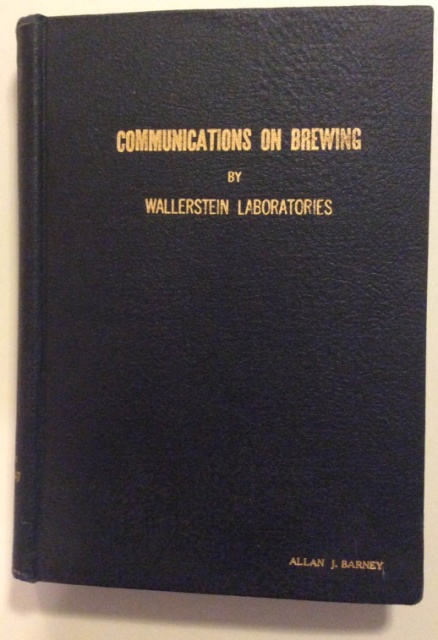 A forward-thinking, heritage-minded individual sent me a volume of Communications on Brewing, a hard-cover compilation of the quarterly technical journal published by Wallerstein Laboratories. This particular volume included the four journals from the year 1951. It is hardbound, with gold embossed printing. He has many of these, originally owned by his father, and wanted to know if they were “worth saving.” The particular gem he sent to me included the following New York Times article:
A forward-thinking, heritage-minded individual sent me a volume of Communications on Brewing, a hard-cover compilation of the quarterly technical journal published by Wallerstein Laboratories. This particular volume included the four journals from the year 1951. It is hardbound, with gold embossed printing. He has many of these, originally owned by his father, and wanted to know if they were “worth saving.” The particular gem he sent to me included the following New York Times article:
Barley and Corn Rain from Skies, but Only on Empire State Tower
The New York Times, August 19, 1950
“It came to pass yesterday that barley and corn rained from the heavens into the open top of the Empire State Building Tower, 1467 feet above Fifth Avenue, and no man could explain it.
“Construction men laboring at that height were peppered with the seed between 9 and 10 A.M., though they heard no plane motors overhead, nor sighted aircraft. There was no wind and no storm, only thick haze and lowering overcast.
“It stung their faces and necks, as hail might, and made tinkling sounds upon the stainless steel flooring under the opening where the tower's cap had been before they removed it to make way for a new television mast.
“Nowhere else in The Great City was there barley rain and corn from the sky.
“A quantity of the seed was carried to Dr. Michael Lauro, official chemist at the Produce Exchange at the crossing of Beaver and Broadway. He proclaimed it malt barley, even such as brewers use. It grows in great abundance on the Midwest plains and in the Northwest. But nowhere in, or about, The Great City.”
Several “savants of renown” offered their personal explanations: perhaps birds of passage, perhaps brewery chimneys, or perhaps grain elevators, with each explanation requiring a brisk, high wind to support it. The New York Times article then diffuses the “brisk wind” possibility:
“The strength of this learned conjecturing was somewhat sapped by Ernest J. Christie, the official in charge of all meteorologists at the United States Weather Bureau. He consulted multitudinous graphs and charts, all rich with isobars and windpaths. ‘...my charts here clearly indicate that at the upper levels, where the wind is strongest, velocity this morning never exceeded five miles an hour,’ he said.”
The article continued:
“Mysterious phenomena, in our own and in ancient days, have been abundant. In 1842 New York City was startled by a rain of toads in a deep storm. Cattail seeds blanketed the Great City's chimney tops and its streets in 1931. There is a rich legend of rains of frogs, fishes, mice, grain, snails, earthworms, serpents and weirdly colored soot, and other afflictions. The first thought when the grain descended yesterday was the Scriptural manna that fed the exiles from Egypt (Exodus XVI).
“But of the barley rain there was no explanation.”
An explanation did indeed come, and it came from none other than… Wallerstein Laboratories!
"No explanation? Set at rest now all musings and wonderings. All...persons far and wide, may know...that Wallerstein Laboratories, among its manifold activities, on behalf of the brewers of beer, do indeed probe and analyze daily many samples of barley malt, corn, and other grains. ...Chemists and assistants, kindly as they are skillful, spread such grains on the sills of their laboratory windows so that the City's pigeons may in their hunger partake of food. To these laboratory windows do indeed flock many of The Great City's pigeons, for no other morsels delight their fancy quite so much.”
The “explanation” went on to point out that their window sills sit at the corner of Madison Avenue and 34th Street, just east of the Empire State Building, at 1250 feet below the new television tower.
“One well versed in the arts of geometry and the law of the square of the hypotenuse might well reckon as not unreasonable the distance from sill to tower as the pigeons might fly it. All other speculations and conjecturings have been found wanting by the Times’ learned investigators; and so it is ventured no one will now cast doubt on the hypothesis here suggested, to wit, that we look to our pigeons and their foresight in hoarding the surplus of their grain...”
I am still laughing, and simultaneously enjoying yet marveling at the elevated writing style that was so common in our publications, even as recently as this 1951 example (“savants of renown,” “to wit,” “no other morsels delight their fancy”). As I said, brewing heritage is not without humor. And this “Barley Rain” story underscores, yet again, that history and heritage offer such a wide range of insights, enjoyment, complexities, colors, and textures... just like the wide range of beer styles we brewers provide!
